The 12th (- - -) of Christmas
By Carver Mead & Barbara Smith
Reprinted from "Crown Jewels of the Wire", April 2004, page 23
It is December, 2003, and the holidays are bearing down upon us. This is our
12th holiday season together, and it seems like a celebration is in order ---
something exciting and very romantic. Well, what could be more romantic
than a hydroelectric project in the middle of a desert, where almost no rain
ever falls?
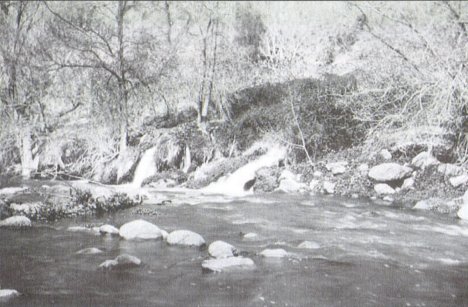
Fossil Springs gushes forth its mineral-laden water on a high plateau in
central Arizona. Its temperature is 72 degrees, and its flow rate is 43 cubic
feet per second, winter and summer, year after year. Ten miles away, the Verde
River has cut a gorge 1600 feet deep into the plateau. In 1900, rancher Lew
Turner filed the first claim to the water for hydroelectric use. In 1903, the
Los Angeles Herald reported that Mrs. Iva Tutt of Los Angeles was "engaged
in a three million dollar enterprise in Arizona. The erection of two electric
power plants to supply power exclusively for mining purposes... She contracted
for water rights, took out her engineering party, following the transit every
step of the way back into the mountains where few men and no woman had ever gone
before, to the head of Fossil Creek, returning with all plans formulated for the
prosecution of the work." Electrical Review called it "A Wonderful
Water Power" .
It was not until 1907, however, that the Arizona Power Company was organized
to pursue the development. On March 28, 1908, construction began on the first
plant at Childs, on the Verde River, which would use 1100 feet of the total 1600
available. A 40 mile wagon road was constructed from Mayer, the nearest railroad
station. The project required a water conduit 38,000 ft. in length composed of
10,000 ft. of concrete tunnels, 12,000 ft. of concrete flume, 2200 ft. of wood
flume on trestles over gulches, 7500 ft. of steel gravity siphon, a reinforced concrete surge tank 36 ft. high and 30 ft. in diameter, and 4800
ft. of steel penstock pipe, made to hold 1100 ft. of head at its lower end. The
power plant itself housed three 3000 H.P. impulse-wheel generators, each with
its associated transformers and switches. A work force of 600 men, backed by 400
mules pulling 150 wagons, completed construction in 12 months.

The original 45kV transmission line ran west along the wagon road as far as
Poland Junction. From there, one branch ran north to the rich mining area at
Jerome, where the United Verde Copper Co. had already contracted for more than
one-third of the total generating capacity. A second branch ran northwest to
Walker and Prescott. Electrical World, Aug. 25, 1910, gave the following
description:

"The transmission line is composed of steel towers, 45 ft. high with
three wires in a vertical plane, on each side of the towers and a steel
messenger wire for lightening protection running over the peak."
"Double Thomas 15-in. hook-and-eye type insulators are used. Thirty-five
miles of the line is composed of No.1 B. & S. seven-strand wire. The two
branches 16 and 24 miles respectively from the junction are composed of No.4 B.
& S. three-strand wire running to Prescott and Jerome." (drawing on
page 14)

So here we are at the Dugas exit from I-17, driving down the old wagon road.
There is a line running along there, but it is made of wood poles! What a
bummer! Finally Barb shouts "there's a tower." Sure enough, there next to the wood pole line is a single steel tower, and by the road is
a sign to go with it.

This is a memorial to the Childs Power Line, sitting there like a grave
stone. The sign reads: "This steel tower was part of a system built to
transmit power from the Childs hydroelectric plant twenty miles east of here to
the towns and copper mines of the Prescott and Jerome areas. Completed in June
of 1909, this transmission line was the first long distance, high energy line in
Arizona. The transmission of power across it gave a vital boost to the economic
development of central Arizona by making possible the economical processing of
ore. One of the boldest engineering projects of its time, the system required
innovations in transportation, construction, and electrical engineering. From
the Mayer railhead, mules hauled 700 dismantled windmill towers and other
equipment as far as forty miles to the rugged country around Childs. In only one
year, an army of workers constructed the line across a mountainous expanse
fissured by deep ravines and subject to extremes of climate. Sections of this
pioneering system still deliver electricity to the region."
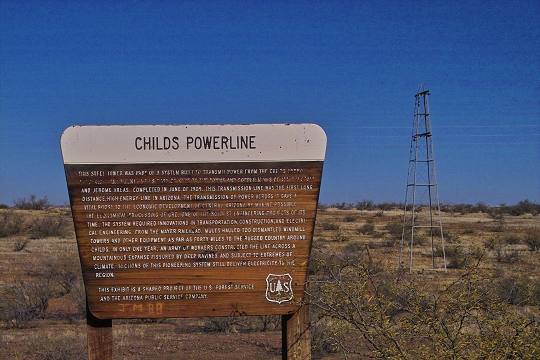
Carver is muttering some choice unprintable comments about anyone who would tear down a steel tower line and replace it with wood poles. There is
hope, however: The sign indicates that some sections of the line are still in
service. We'll have to find out which ones. Driving farther down the wagon road
yields nothing except more wood poles. It is probably like every other historic
line we have explored: We'll only find original stuff in the most rugged,
remote, inaccessible places. So we head for the mountains.
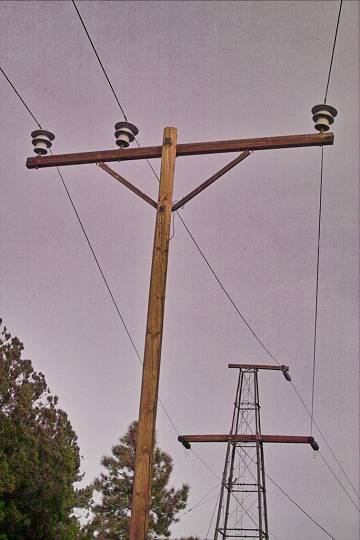
There is a section of the line that runs northeast over the shoulder of
Mingus Mountain and then down to Jerome. Towers are still in service, visible
from the modern highway 85A. We find a, trailhead, and start hiking,
encountering the line within half a mile. These are the steel towers to be sure,
but they have wood crossarms. Of all the crazy things. Lots of small pieces of
flat Thomas suspension plates, but these are the 12 in. ones, not 15 in. like
the article said. We had been suspicious of the 15 in. from the beginning,
because the only Thomas suspension plates that large were the 2-part units used
by Southern Power. In any case, we are on the right line, and finding stuff.
After a couple of hours we are scrambling down a steep hillside to the last
tower before a long span across a deep gorge. We discover why the cholla is
called "jumping cactus" --- it almost leaps out at you, and its barbed
spines aren't impeded in the slightest by leather gloves! After pulling spines
from fingers (ouch!), we explore the tower site. Some broken flat Thomas
suspensions, and two hook-and-eye units with the porcelain broken off. Barb is
rummaging around in a pile of leaves under a bush. After a few minutes she
appears with a whole flat Thomas suspension plate, unharmed except for three
radial stress cracks. Wow, a whole one!
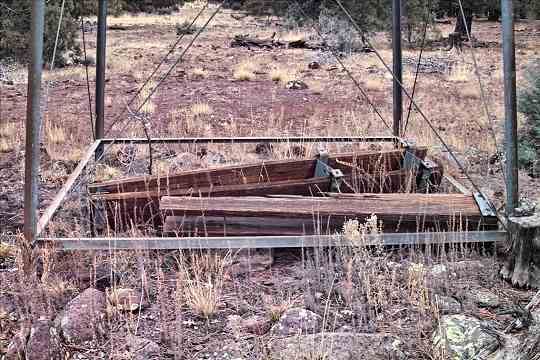
Line maps from 1916 show a second line running north-northwest from the plant
up along the Verde River and directly into Jerome. Part of this line runs over
the shoulder of Squaw Peak, quite far from any access. Because this section is
of later origin, it is unlikely to have the original insulators, but we have
been surprised before. Let's check it out. We drive south from Camp Verde to
Rodeo Flats, and start hiking. The line there looks like just another wood-pole
line, equipped with modern 4-string suspension insulators. Several pole sites
have abandoned crossarms scattered about. Then Barb unearths the core of a
modest-sized three-part pin-type insulator. It must be original, judging from its crown and wire groove. Couldn't be more than
30kV. Hmmm. We trudge on. Up
on one lonely, wind-swept ridge stands a tall, handsome, modern pole. Fifty feet
away there is a group of three pole stubs of decreasing size and increasing age.
Under a bush not far away are two hook-and-eye units with porcelain broken off.
So they did use them here! Carver is studiously contemplating the scene when he
hears a faint voice "come over here". There in the middle of an open,
grassy area is a mint flat Thomas suspension! In the most unlikely place!

The Bradshaw Mountains are high and rugged. There are numerous old mining
roads, and a lot of public land laced with thickets of private mining claims. It
is often hard to know where we are relative to private land boundaries. At
first, we drive public roads to get a feel for the area. The line is shown
clearly on modern topographic maps, but when we drive to the place where it
crosses the road, it just isn't there! Well, this is not an auspicious way to
begin. Back to the maps. More driving. Some wood poles. More maps. More driving.
Finally we head for the most remote section we can find on the map. One hiking
trail is shown crossing it. As we break out of the pine forest there is a tower!
Still in service! And it has the original metal crossarms! And it has the
original metal crossarms! And the line keeps going for miles! Now we can hunt!
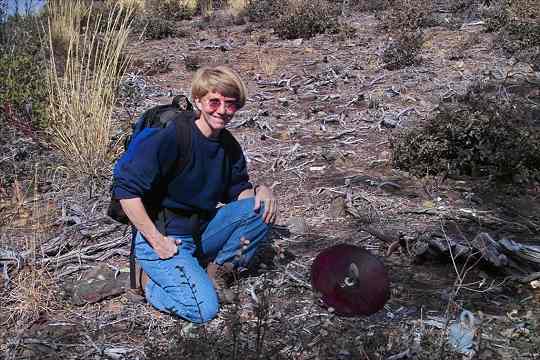
Numerous broken Thomas pieces litter the area, along with a few hook-and-eye
units. The line is headed downhill, along the side of the mountain. Each tower
is located on a ridge. Towers are separated by gulches of various depths. We are
so excited that the terrain doesn't seem that bad. After a few dozen towers we
are getting really far from the trailhead. We now have a lot of Thomas plates
with half to two-thirds of their porcelain, and the possibility of finding the
missing pieces. Perhaps this whole hunt will turn into a giant glue job! Then we
reach a corner tower, where the line makes a turn. These are always good because
they used two to three times the number of insulators.

Carver shouts "hey, there's one." Sure enough, on the lower edge of
the right-of-way are two big, flat Thomas plates! We pull them out, dust them
off, and one of them is mint! Barb starts exploring a big pile of dead limbs
left by the brush crew on the upper side of the right-of-way. Sure enough, more
plates under there. After pulling off limbs and digging out plates, we have
three more good ones, along with a dozen broken ones. Back to the cut brush on
the downhill side. More under there. More moving brush, more digging, more
broken plates, but two more good ones. This one site has yielded six flat Thomas
suspension plates in mint condition. Three of them are nice red glazes with dark
red drools.
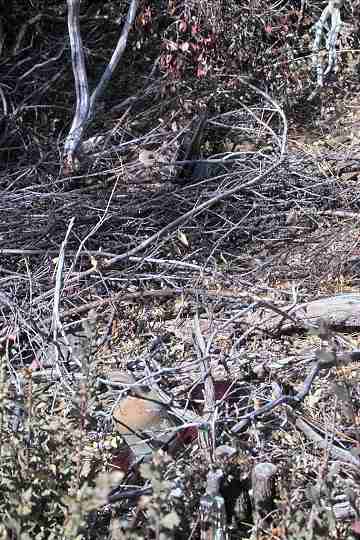
We are on such an adrenaline high that we press on down the line. A few more tower sites with only broken pieces. Then a tower where the brush crew
has left three mint plates right by the tower. "That's too easy" says
Barb. Carver looks back up the line "we don't have them out yet!"
There are two more towers before the next really deep gulch. At the last one, we
spot a plate in the brush. It is perfect, and has a nice light glaze with
burgundy swirls. We carry these four back to the original find.

Here we are, miles from the truck, with at least a thousand vertical feet to
climb, in possession of ten flat Thomas suspension plates, all in mint
condition. Be careful what you ask for, you might get it! There is room for
three in Carver's pack, and two in Barb's. That means two trips. We pack up the
prettiest glazes first, and hide the others in the brush. Back up the hill we
go. Trudge, trudge, trudge. Down into one gulch, then up the other side. One
gulch after another. "It seems a lot longer going back" says Barb.
"Maybe it isn't too easy after all" says Carver. It is very late when
we get to the truck. We are very sore. But we now have six mint Thomas plates in
the truck.
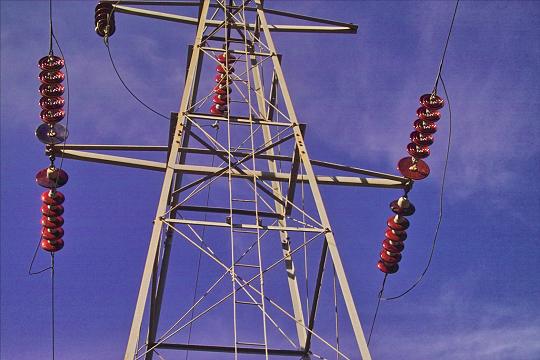
"There must be an easier way to get there" says Barb. We check the
map and drive some roads looking for a likely approach. One gulch would get us
about the same distance from the stash, and about the same vertical climb, but
it is below the site instead of above it. That means we climb up empty and come
back full. Sounds like a plan, so off we go. We are still sore, but it seems a
lot easier empty. We get to the line and make our way toward the stash. Barb
spots a piece of the original three-strand conductor. We leave it there, to be
picked up on the way back. Then there is a 4-string of the oddest Westinghouse
plates we have ever seen. We'll pick that up later as well. Then there is a
petticoated hook-and-eye suspension which must have been the replacement used
for the flat plates. We'll pick that up later as well. We press on, and find the
stash just as we left it. We pack the remaining five plates, have some water and
a power bar, and start down the hill. Well, mostly down hill.
It is still a long drag with a heavy load, and it gets different muscles
torqued out. Finally here we are at the truck, with a total of eleven flat
plates. One more and we could equip a whole tower. "Where are we going to
get a tower?" asks Barb.
Now it is the day before Christmas, and we have been at this for a week. We
make a dinner reservation at Murphy's, the most historic and romantic restaurant
in Prescott. We grab a mocha at the Mud Hole (coffee shop named after a historic
mine that was served by the line) and get an early start. We have to go back to
the stash to get the conductor, the Westinghouse, and the petticoated
hook-and-eye. After retrieving these goodies, we stash them at the nearest point
to the truck, and start exploring in the opposite direction. Wow! Here is a
tower with three of the original flat Thomas plates and one petticoated
hook-and-eye still in service! We notice that the Thomas suspensions come in two
distinct types, one having a square-shaped cap, and the other a more rounded
cap. The square-capped ones seem to have the prettiest glazes.
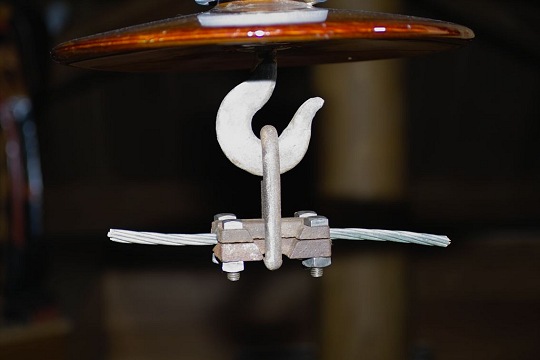
"What is this" asks Barb, holding up a rusty contraption. Well,
Electrical World says "The wire hardware between insulators and copper is
composed of a pair of iron blocks bolted together with four bolts similar to the
old bolted come-along which is in turn supported by a link. This clip prevents
the slipping of the wire and at the same time is flexible and allows for a
change in the position of the insulator without in any way kinking the
wire." In the pack it goes.
One detail not mentioned in the article is that the clamp had to work with
both the seven-strand and the three-strand conductor. The simple solution was to
make both halves fit the larger conductor. When a single copper wire clip was
added around the top half of the clamp, the result was a clamp that would hold
the smaller conductor.
We press on. There, right in the middle of a tower, the rim of a flat plate
is showing just above the dirt and rock. It has the most beautiful light mustard
glaze, with burgundy swirls. We must have it. It is buried from a small slide
that engulfed the site. We dig, and scrape, and pry, and dig some more, and
scrape some more, and finally get the buried rocks loose from around it. One
last heave and out it comes --- with about a third of the porcelain missing.
Bummer!
There is one more tower before a heroic span over an incredibly deep gulch.
This will be the last one of the day. We don't see much, and are about to leave
when Barb spots something in the brush. It is a Thomas. It is whole. It is mint.
It has a beautiful light mustard glaze with deep burgundy swirls. It is
beautiful! So there it is --- the 12th Flat Thomas Suspension of Christmas. So
that is what the song should have said! Well, now it does, at least for us. The
lug out seems less taxing today. Christmas Eve dinner at Murphy's is especially
romantic knowing all twelve plates are lovingly wrapped in their blankets and
tucked safely in the truck. Now we have to find out where we can get a tower.
Maybe next Christmas.

Sources:
Drawing of Thomas 1053: 1917 Northern Electric catalog, courtesy Elton Gish
Electrical World, Aug. 18, 1910, p. 361 and pp. 373-430
Journal of Electricity, Power and Gas, Oct. 5, 1907, pp. 289-290
Engineering and Mining Journal, June 22,1918, pp. 1113-1116
A Wonderful Water Power by Stephen A. Monroe Superb on-line photo essay:
http://www.pinestrawhs.org/childsirving.htm
|
